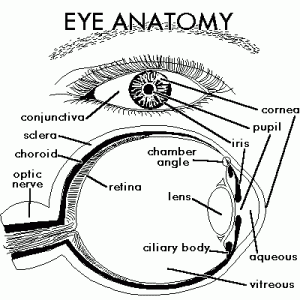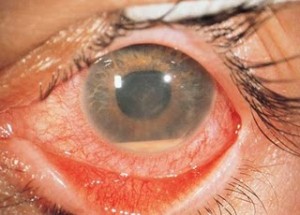Mila Kunis reveals secret health condition

It’s no secret Mila Kunis has eyes that are the envy of women everywhere.
Black Swan co-star and Golden Globe nominee Mila Kunis reveals in the February issue of Cosmopolitan magazine a secret health condition: “I was blind in one eye for many years, and nobody knew … I’m not blind anymore. I had surgery a couple of months ago. They cut it open and dropped a new lens in there.” The blindness was caused by a condition called chronic iritis. The condition caused a cataract in that eye which affected her vision. Replacing the lens in the affected eye restored her sight.
 A brief anatomy of the front of the eye:
A brief anatomy of the front of the eye:
The iris is the colored part of the front of the eye. It controls light that enters the eye by controlling the size of the eye’s opening (the pupil).
The ciliary body is a group of muscles and blood vessels that changes the shape of the lens so the eye can focus. It also makes a fluid called aqueous humor. Aqueous humor is a clear, watery fluid that fills and circulates through parts of the front of the eye.
The lens is a transparent, biconvex structure in the eye that, along with the cornea, helps to refract light to be focused on the retina. The lens, by changing shape, functions to change the focal distance of the eye so that it can focus on objects at various distances, thus allowing a sharp real image of the object of interest to be formed on the retina.
Iritis is inflammation predominantly located in the iris of the eye. Inflammation in the iris is more correctly called as anterior uveitis.
Uveitis occurs most frequently in people ages 20 to 50, and affects men and women equally. It is estimated that more than 280,000 people in the United States are affected by uveitis each year and that uveitis is the reason for 30,000 new cases of blindness a year and up to 10 percent of all cases of blindness. The disorder may affect only one eye.
Although iritis/uveitis can be associated with many medical conditions, such as autoimmune and infectious disorders, at least half of those affected are completely healthy.
Symptoms of Anterior Uveitis:
- Redness of the eye
- Blurred vision
- Sensitivity to light (photophobia)
- Dark, floating spots along the visual field
- Eye pain
Treatment may involve:
- Dark glasses
- Eye drops that dilate the pupil to relieve pain
- Steroid eye drops
Cataracts are a common complication of uveitis. Cataracts are a clouding of the eye’s lens. In the US, cataract surgery is a commonly performed procedure to replace the damaged lens. Eye doctors can remove the eye’s natural lens and replace it with a special plastic lens. However, if the cataracts are related to uveitis, eye doctors may not be able to perform surgery until the inflammation caused by uveitis is brought under control. In most cases, eye doctors want the eye to be free of inflammation for at least three months before performing cataract surgery.
Long term use of corticosteroids used to treat uveitis can also increase the risk of developing cataracts. The type of cataract developed by long-term corticosteroid use causes the most visual disturbance.
Other possible complications of anterior uveitis include fluid within the retina, glaucoma(increased pressure in the eye), detachment of the retina and vision loss.
For more information about chronic iritis, click here to go to the Resounding Health Casebook on the topic.

























6 Comments